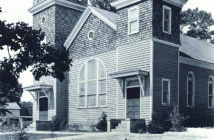The courtship of two Barred Owls began in February on Winfree Street in Chester. After courtship feeding and mutual preening, the Barred Owls settled in a tree hollow of an aged oak tree on Gene and Lynn Alexander’s property at the corner of Winfree and West streets. The Alexanders, neighbors and children began owl watching in early April when Gene Alexander discovered the first baby owl emerge from the tree hole. There were two; named by Alexander, Big Hootie and Little Hootie. Last week, Little Hootie was the last to fledge, joining Ma and Pa Hootie and its sibling, hootin’-away among the tree-lined streets of Old Chester.
“It has been exciting to watch them,” said Alexander. “All the kids and neighbors loved watching them. The bus stop is right at the corner and the kids would come over after they got off the bus and check to see how they were doing. They [the owls]would sit right there [pointing to the tree hollow]and watch the children.”
According to Owl Page 8 website, the Barred Owl is a fairly large owl with a large, rounded head with no ear-tuftsThe females can lay two to four eggs and likely laid two to three days apart. The male brings food to the female while she is on the nest. The young crawl out of the nest using their beak and talons to sit on branches when they are around four weeks old. They fledge at 35 to 40 days. Once they lose their down, there is no difference between adult and juvenile plumage.
“They grow so fast,” said Alexander. “I am sure glad they were here.”
Alexander made another discovery in his yard and learned a little more about owls. “They are called owl pellets,” he said. “They eat mice and moles but cannot digest their fur and bones. What they cannot digest, they regurgitate it and it is called pellets.”
Ma and Pa Hootie will care for their young for at least four months; much longer than most other owls. Young tend to disperse very short distances, usually less than six miles, before settling. Pairs mate for life and territories and nest sites are maintained for many years. According to Owl Page 8, Barred Owls have been known to live up to 32 years in captivity and 10 years or more in the wild. Most deaths are likely to be related to man (shootings, roadkills etc). Great Horned Owls are their only natural enemy.

